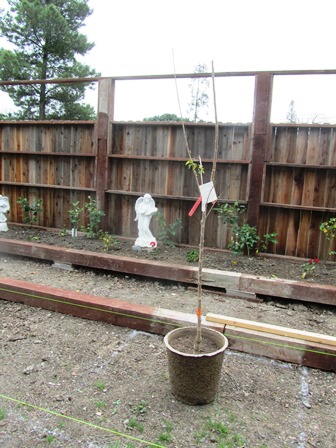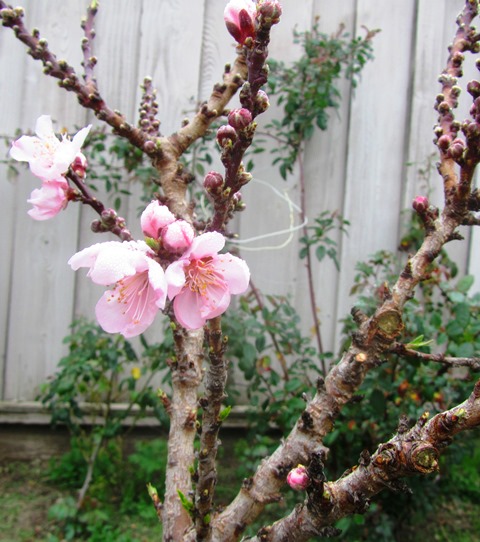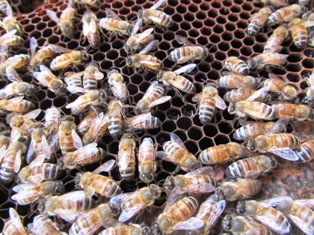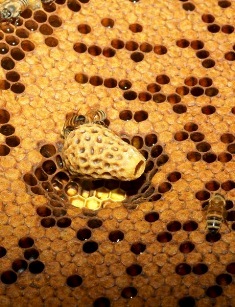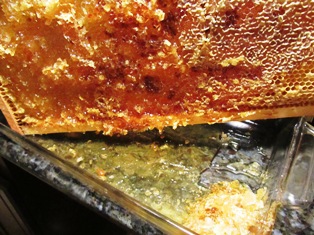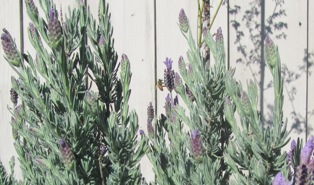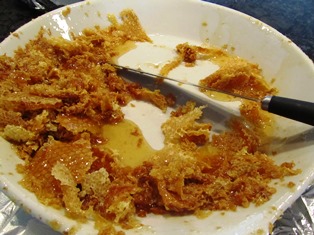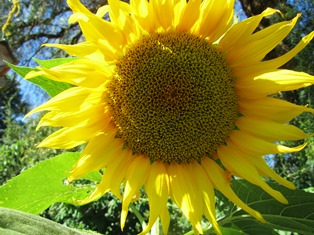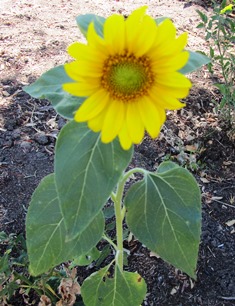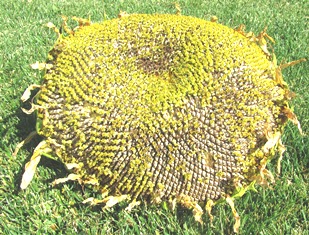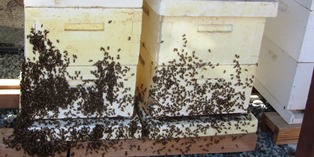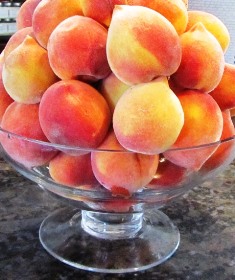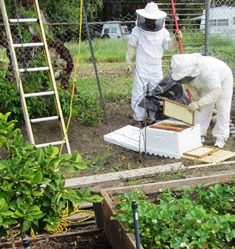Blog Archives
The Start of Something Wonderful . . . Spring!
I jumped at the chance to visit my favorite nursery this past weekend after my husband suggested a drive to Livermore, California. Alden Lane Nursery occupies a beautiful setting amid ancient oaks and there is even a honeybee hive on the premises. Wisteria blooms in perfusion there this time of year.
We came away with some pepper plants, two smoke trees, and four cherry trees, including Bing and Black Tartarian, its pollinator.
We are going to plant the cherry trees at the front of our property and the smoke trees will go in that area as well. We’ve done very little landscaping on the front of our land, preferring to get the trees and gardens in at the back near our hives and chicken run.
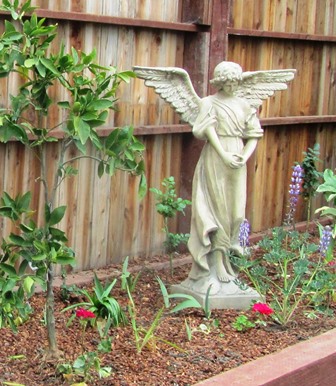
The beds that run the length of the fencing at the front of the farmette feature statuary, citrus, and bedding plants
Everywhere you look on the farmette, there are projects to be done. We chip away at them when we can. My husband works days and I write my novels, so the work will undoubtedly be never-ending. But that’s okay. We aren’t in a hurry and it’s easier to just live by the cycles and seasons of nature.
When I think of how the peaches and apricots are forming and the bees are almost ready to swarm, I know spring is here. And it’s my favorite season, so I’ll go outside, ignore the projects, have a cup of tea, and enjoy the start of something wonderful!
Blooms over the Garden Gate
The nectarine trees are susceptible to Peach Leaf Curl and usually, I try to spray them three times before the next year’s blooms. Alas, this year, I didn’t complete the task before the tree broke bud.
Elsewhere, the almonds, apricots, and apples are blooming. So are some of the roses–Lady Banks, for example. Also, Fiesta and the beautiful Iceberg rose in the front of our house.
My neighbor’s two almond trees are covered in blooms of white blossoms. Last Friday, when I contacted a local beekeeper business, I was told they were closed to move their hives of bees out to pollinate the almond orchards. Farmers pay the beekeepers for “renting” those hives of industrious little bees for the job of pollinating their crops.
This is supposedly “bare root” season, but the warm weather coupled with the rain we had in December seems to have brought us an early spring. If you look over my garden gate, you will see signs of it everywhere.
Working the Beds after the Weekend Storm
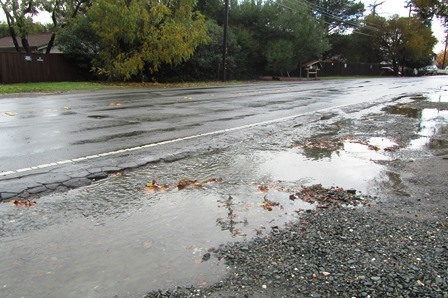
A “Pineapple Express” rainstorm with gale-force winds blew out the power and made for slick roads as well as ponds in our clay soil
The weekend storm is still a vivid memory, what with the fence along one side of my property beaten down by high winds and pounding rain that also brought a power outage on Friday night.
But today with outside temperatures in the 70s Fahrenheit, I cleaned my strawberry beds. Somehow, mint had crept in and I don’t want mint with my berries although I like it served that way for dessert.
My neighbor’s relative, who’s visiting from Lebanon where they grow apples in his mountain village, share a suggestion for digging dried chicken manure around the bases of my trees. The high nitrogen will get them off to a great start and my trees have already broken bud (which is attracting the honeybees).
The wild bird population seems to have exploded and I see signs of nest building starting. The five suet cakes I hung in trees for the songbirds, blue jays, and woodpeckers last month are down to a fraction of their original size.
I extended the chicken run with poultry wire high enough to keep the my heritage girls from flying out. Now, they’ll have plenty of space on both sides of the chicken house to forage and out the beds I’m working.
Time to Open the Hives, Check on the Bees
My honeybees have become surprisingly active for the dead of winter. Local forecasters tell us that the Bay Area temperatures may reach 80 degrees Fahrenheit by the end of the week. My apple and early peaches won’t wait; they’ve already blossomed.
The warm weather, time of year together with the fact that almond trees will be blooming in a couple of weeks and the lavender around my farmette is already blooming tells me I have to open the hives. My beekeeper neighbor says that his bees are already out collecting pollen–lots of it–and that means we have to get to work.
The hives have to be checked now for mold (that long period of hard rain in December caused some of my neighbor’s frames to mold). Moldy frames can’t be renewed; they have to be tossed. Honeybees can get nosema (with diarrhea), which shows up as spots at the base of the hive.
The bees are finding flowers on their forage runs and are returning to the hive laden with pollen.
Bee queens will be busy laying eggs in the coming weeks, if they aren’t already. This is the time for beekeepers to purchase new queens. By the first week in April, it’s possible we could see swarming.
So here’s the plan. If the hives have a lot of honey, I’ll harvest some. Strange to be doing that in winter, but the hive will need space for brood. I’ll have to remove frames of honey and insert empty frames with wax (put in the freezer first for a period to kill any pest they might be harboring over).
I’ll put bee food patties in the open hives, so they’ll have plenty to eat (once I take some of their honey). My beekeeper neighbor tells me this will get the hive “heated up” for the queen to do what she does best–lay the eggs.
With so much activity, I’m confident that everything will turn out well, but you never know until you’ve inspected the interior of the hive and checked out everything, including the possibility of mold or the presence of pests or illness.
Mother Nature didn’t ask me, but I would have preferred she wait another month before removing her winter robes and dressing in spring florals. It just seems like now everything to do with the hives is on fast forward!
The Bee Garden Favorites
I spent Sunday building a rock circle around the circumference of our towering elm tree. I want to conserve water around the base of the tree and to also grow more plants for my bees to have abundant food.
We had a pile of river rock donated to us, so I thought it might look nice to create a wide circle, maybe three feet high around the tree like a watering basin/retaining wall, using the rock.
Inside the circle, I transplanted some yarrow and white geranium. Already, there are white roses that boom all summer long under the tree.
But bees like nectar-rich plants with pollen, so I’ve put together a list. Over the next week, I’ll add some of these in my new bed beneath the elm. This is a partial list of plants bees love.
- Rosemary
- Lavender
- Russian sage
- Basil (African blue)
- Honeywort
- Mexican Sunflower
- Borage
- Cerinthe
- Greek oregano
- Sweet marjoram
- Purple coneflower (echinacea)
- California poppies
- Lupine
- yarrow
- sunflowers
Eucalyptus on the property behind our farmette is not yet covered with fall bloom. The bees love that bloom but now they make do with the star thistle on the brown hillsides and by foraging on the French perfume lavender and the Spanish variety in my garden.
Of late, I’ve discovered the honeybees foraging on the sweet nectar at my hummingbird feeders, so I worry about them getting enough food. The drought has sapped everything. At any rate, I’ll hold off taking honey this fall, leaving it in the hives for the bees. They’ll need food to get through the rainy season.
Drought Hurts Honeybees, Too
The star thistle blooms in yellow bursts of color over the brown, drought-parched hills of the Bay Area during summer. Widely considered a noxious, invasive weed, the yellow star thistle’s blooms serve as a source of food for the honeybees during drought conditions when flower sources become scant.
While naturalists, government officials, land management people, ranchers, gardeners, farmers, and road and park maintenance workers consider the yellow star thistle challenging to control, others lament indigenous plants suffer or die because the yellow star thistle depletes the soil of moisture. Its one redeeming value appears to be as a food source for the bees.
Local beekeepers understand the value of the yellow star thistle during severe drought when water rationing in many counties mean few if any flowers are left blooming in August and September. While the plant’s nectar is great for the bees, it’s bad news for horses. Feeding on yellow star thistle over time can cause a horse malady known as chewing disease.
Also called St. Barnaby’s thistle and yellow cockspur, the yellow star thistle’s long tap root keeps it going while other plants around it die from lack of water. In Europe where the plant is indigenous, it is held in check by other plants that have co-evolved with it and by herbivores, the enemies of yellow star thistle. However, that’s not the case in the United States.
Since it was introduced to America in the early part of the 20th Century, the yellow star thistle has spread faster than a California wildfire and now covers some 15 million acres, just in this state alone. It is also considered a noxious, invasive weed in 35 other states. But the honeybees don’t care as long as there are enough of those yellow blooms to get them through the dog days of summer.
Harvesting Honey the Old-Fashioned Way
Last weekend, my beekeeper neighbor and I harvested three frames of honey from my hives. I took the frames into my house and, with a hot knife, cut open the wax cells to permit the honey to drain.
I drained off one-half gallon of honey from two frames.

Two frames drain simultaneously in a five-gallon bucket; another option is to use large, flat plastic tubs
I wrapped the extra frame in foil and froze it until I am ready to drain that frame as well. Then, I will let it thaw for 24 hours before draining off the honey.
Once all the honey is out of the frames, I take the frames outside and hang them in the tree near the hives. The honeybees will do the cleanup, foraging all the honey and leaving only clean wax that I can melt for candle- or soap-making projects.
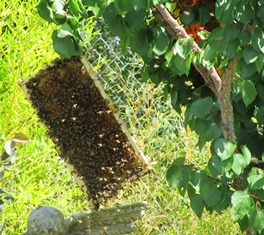
A frame of wax and residual honey is hung in a tree so the bees can clean it, hopefully before the ants find it
Draining honey from frames is a lengthy process and I have to do it twice: once to remove the honey and the second time to strain out any tiny particles of wax, before bottling it.
Last time, I took 20 frames and my neighbor, who was harvesting too, ran those 20 frames through his motorized extractor in his honey room.
Extractors are a modern convenience that saves untold hours extracting honey. But until I begin to sell my honey and other farm products, I won’t be able to afford such an energy-efficient tool.
I’ve discovered that beekeeping can be quite the expensive hobby. There are uncapping tubs, melters, comb cutting pans, heated knives, thermal plastic shrink bands for jars, uncapping needle rollers, and myriad other items used in honey extraction.
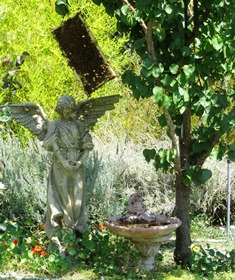
The tree near the hives holds two frames and a strainer of wax/honey from the uncapping of the cells that I also drained
Radial extractors can save time and preserves the honeycomb. The frames are placed between the guides of the stainless steel tank and the reel spins. The centrifugal force created throws honey against the sides of the tank. Honey is drained off through spigot. For now, the old-fashioned way works fine, too.
Sunflowers-A Source of Beauty and Food
Sunflowers have inspired human expression for centuries. The Incas made the sunflower a symbol of their god. In Europe, sunflowers symbolized kingship and were cultivated in gardens, at least until the 18th Century when they fell out of favor. The artist Vincent Van Gogh immortalized these sun-facing flowers in his paintings that bear witness to the hot summers he spent in Arles.
In fact, nothing symbolizes summer like the sunny faces of sunflowers. That image of beauty is a widely used motif in garden art and home goods. Freshly cut sunflowers in a jar, vase, or tin can brighten any room in which they are placed.
Native Americans ate the seeds or ground them for use in breads and cakes and used the dyes for body paint and clothing. Today the seeds are dried and roasted or sold as natural. The oil is pressed and used in cooking. Sunflower seeds are high in protein and are considered a healthy snack.
Even children can plant and tend sunflowers; they are easy to grow. The giant cultivars require ample garden space but planted in a circle or square, they can become a living fort that children enjoy playing under. Sunflowers are heavy feeders, so amending the soil with compost and manure will benefit their growth cycle. The plants are not particular about soil type but they do need regular watering.
Sunflowers can bear a single head, containing petals and seeds, or several heads on a single stalk. They range in size from small to giant stalks of twenty feet or more. Giant heads grow as much as two feet across.
Depending on the cultivar, the centers of these lovely flowers range from dark brown or black, or gray and white striped. The seeds are a favorite food of squirrels and birds and honeybees. Here on our farmette, we grow sunflowers near the apiary along with lavender. High-value food sources keep the bees around to pollinate the rest of our garden. And I can’t resist putting a few small heads in a jar to brighten my kitchen window.
Puzzling through a Cozy, Weeping at a Memoir, and Forgetting the Peach Pie
I couldn’t breathe in yesterday’s heat. But with so much work to be done around the farmette, I soldiered on, staking heirloom blue tomatoes. I hadn’t finished canning my organic apricots and now the plums and peaches were ready. I felt overwhelmed and longing for cool spot to sip tea, rest, and read.
We had already removed the apricots from our “torture tree” since we’ve been unable to surmount its many problems after planting it five years ago. Carlos wasted little time chain-sawing it down. I deadheaded the roses, while he dug out the stump.
Then with a clear view to our hives, we quickly realized that the we needed to suit up and install extenders or the bees would swarm. Even as we felt the urgency, we realized there were also dozens of other chores screaming for our attention.
I told myself that breezes would soon blow inland from the Carquinez Strait, a channel of the San Francisco Bay where the San Joaquin and the Sacramento Rivers flow to the ocean, but by mid-afternoon, nary a leaf moved on the apricot, plum, and pomegranate trees. By four o’clock when the wind finally did kick in–the air wasn’t cool as it usually was. The winds blew strong and stifling hot and threatened to suffocate anyone still working outside.
Abandoning the outside chores, I retreated indoors and turned on the air conditioner. Seeing the lug of apricots and crock of peaches resting on the kitchen counter, I groaned. The jam had to be made, but I couldn’t face stirring boiling fruit on a hot stove.
Deciding to use up some of the fruit for a simple after-dinner dessert, I flipped through the pages of a few cookbooks. Maybe a cobbler would do or a peach pie. I really didn’t need a recipe for those, but in Country Cooking by Dori Sanders, I found an intriguing raisin-cinnamon crust that sounded tasty. I bet it would go with peaches but I probably could have baked it on the patio floor.
With a glass of sweet tea and an armload of paperbacks and hardcovers, I curled up on the couch and finished reading Murder is Binding, Lorna Barrett’s debut book in her cozy Booktown Mystery series. I love this author and her writing, but soon figured out who done it. Still, I read to the end; you never know when a clever twist might show up.
Next, I read the last few pages of A Tuscan Childhood by Kinta Beevor. At bedtime, I’d been savoring the chapters of that book like pieces of rich, dark chocolate. Beevor’s evocative descriptions of her bohemian childhood in Tuscany captured my imagination, drawing me in so completely I could almost smell the wild thyme, pine needles, and rocky Tuscan terrain in the searing, summer heat. Like Frances Mayes (Under the Tuscan Sun), who wrote a quote for the cover, I felt sad when Beevor’s lovely memoir ended.
Returning to the stack, I selected another memoir, The Orchard, by Theresa Weir. I’d bought the book on impulse during a trip to the farmers’ market at Todos Santos Plaza, our downtown green space surrounded by bars and banks and, of course, a second-hand bookstore. Drastically marked down, the book had been summarily deposited on a set of moveable shelves, and rolled outside the storefront for a quick sale.
The artist and writer in me understood immediately why I had picked it up and purchased it: the cover art pictured a young couple in a loving embrace, standing in lush green grass surrounded by apple trees. But there was something in that image that evoked sadness, like a bittersweet dream of a time past, viewed through a long lens.
As the descendant of five generations of farmers, I suspected Weir’s book would resonate with my own experiences of farm life in America’s heartland with bone-chilling winters of snow and ice and sweltering summers when you prayed for rain. What I didn’t expect was exquisite writing and the juxtaposition of love against the deadly realities of widespread pesticide use on the farms that ushered me into her story and swept me along. I finished that book in one sitting and will long be haunted by it.
I felt guilty for having only paid pennies for Weir’s book. A pittance for a tale that evolved out of all she had lived through. Less than the price of bus fare to journey with her as she pieced together scenes from her life in the Heartland. In every page, I was with her as she struggled, never abandoning her dreams. She learned as I had how to tuck them away while you dealt with the realities of a hard life with heart-breaking lows and highs that reached euphoria. But there were scenes she left out, only hinting at experiences she said she would “never talk about.” The truth is, I wept after putting down her book.
When a reader identifies so closely with a character in a story (and this was Weir’s personal narrative of her life), he or she rides the emotional ups and downs with that character. Good writers understand how to tug at their readers’ emotions and milk the drama. Theresa Weir had skillfully threaded a leitmotif of darkness and light, joy and sorrow, pain and healing through her story, but never once did I feel manipulated. Every sentence of The Orchard rang true.
I couldn’t read anymore after putting that book down. As I made dinner, I thought of how many scenes in her life resonated with mine. Even the widespread pesticide use on farms and the stubbornness of farmers to change.
I thought about Rachel Carson’s famous book, Silent Spring, that sounded the wake-up call to farmers everywhere about the dangers of chemicals in fertilizers, pesticides, and herbicides. So many small farms have been overtaken by agribusinesses these days and still the chemicals are used. I decided to forgo making the peach pie.
With the heat of the day gone, I opened the windows and stretched out between freshly washed sheets. I listened to the rustle of oak and eucalyptus leaves. To crickets and the unseen critters that make noises in the night. I listened to the soft voices of my Lebanese neighbors chatting in their orchard with relatives.
As dreams beckoned, I could almost smell the fresh lilacs that Theresa Weir had written about in her memoir. Their cloying scent had filled her grandmother’s kitchen just as they had filled my grandmother’s, my mother’s, and mine. I wondered if the lilacs would ever disappear or if the world would one day wake up to find the honeybees gone, the fruit trees without fruit, and the berries and other sweet produce in our gardens and orchards reduced to a memory.
Swarming Season Has Arrived!
What’s not to love about spring? It’s only the middle of April and already we’ve seen several honeybee swarms. Swarming is how the bees reproduce their colonies and most often occurs during the warm days of early spring.
My neighbor, whom I’ve often called a world-class beekeeper (his father kept honeybees in Lebanon and taught him well) permitted me to keep his bee swarm that alighted in my apricot tree. He also generously donated a super (hive box) with some frames that already had wax, honey, and capped brood–all from his own apiary.
The newly housed honeybee workers delight in foraging on the various types of lavender (Spanish, English, and French perfume) that I’ve planted around the farmette. The colony will build up the wax and make honey while the nursemaid bees will care for the brood.
My husband, the architect-turned-farmer/beekeeper, has constructed a unique bee house for the hives. It will keep the bee boxes dry during winter rains and out of reach of marauding animals (skunks and raccoons). Resting on a platform that Carlos built on top of a newly installed brick floor, the hives are not within easy reach of the ever present ant population.
Alas, the bees weren’t about to wait until Carlos finished building their house. The swarm happened when the bees were ready to take flight (some 60 percent of the workers with their old queen) flew into our apricot tree.
If you see a swarm, call your local beekeeping association (or any store that carries local honey) for the name of a beekeeper. Avoid the temptation of spraying water or anything else on the swarm. Permit the beekeeper to safely remove the swarm.
For a beekeeper, rescuing a swarm is a truly exhilarating experience. Often a swarm consists of thousands to tens of thousands of honeybees. Beekeepers routinely rescue swarms from where bees have temporarily clustered while the bee scouts seek a permanent home. The beekeeper can shake them into a prepared hive box, leaving the box at the hive cluster site until all the bees are inside. At that point, the beekeeper takes the new hive to his apiary.
The beleaguered honeybees (whose populations have been decimated by the Varroa mite, weakened immune systems, and Colony Collapse Disorder) need help to survive and increase their populations. We need them, too! Without their pollination of fruit, nut, and other crops, our own food sources diminish.
Saving the honeybees is a good practice whenever possible because doing so ensures abundance and diversity in the plants we eat. Whenever I see a cluster of bees in a tree I feel joyful and celebratory. Is it any wonder that swarming season is my favorite time of the year?
 Facebook
Facebook Goodreads
Goodreads LinkedIn
LinkedIn Meera Lester
Meera Lester Twitter
Twitter




